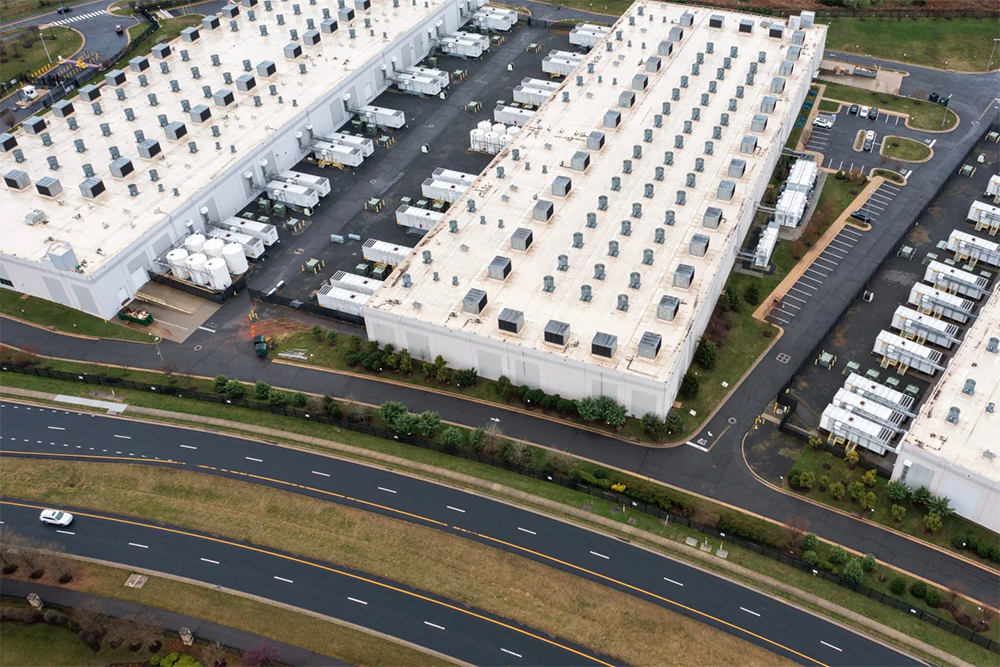如果你使用生成式人工智能,就会知道它看起来很神奇。只需要动动手指,聊天机器人和多媒体模型就能够毫不费力地创作出诗歌或者高清视频。
但人工智能模型的快速输出和流畅界面掩盖了为其提供支持的大量物理基础设施。随着人工智能的不断发展,其所依托的数据中心和发电厂开始受到行业外的广泛关注。
上周早些时候,我乘火车前往美国纽约州奥兰治堡,位于哈德逊河谷下游的一个冷清郊区,距离《财富》杂志位于曼哈顿市中心的新闻编辑部只有25英里(约40.23千米)。我在那里参观了全美各地涌现的人工智能基础设施项目之一——奥兰治堡是数据中心公司DataBank的最新基地(名为LGA3)的所在地。
DataBank已经在纽约大都会区运营着两个数据中心:一个位于新泽西州纽瓦克,另一个位于曼哈顿切尔西。但LGA3数据中心将是迄今为止最大的数据中心,该设施耗资2.5亿美元,占地20万平方英尺(约18,580.608平方米),可以提供高达45兆瓦的能源,为五个装满计算机芯片的大型数据大厅提供动力。
该设施明年才会启用,但租户已经开始预订空间,其中最引人注目的是总部位于新泽西州的人工智能初创公司CoreWeave。该公司最近获得了令人瞠目的190亿美元估值,并已经预订了LGA3近一半的容量。
CoreWeave的创始人本·文图罗在发给我的一份报告中写道:“人工智能的爆炸式增长要求对传统数据中心进行全面重新评估,以满足下一代计算需求,而这一新数据中心园区提供部分最先进的新技术,使我们能够为客户提供服务。”
我乘坐的出租车从火车站出发,一路经过农舍和办公园区,来到位于变电站和新泽西州州界之间的LGA3建筑工地,途中拐错了不下四个弯。下车后,我的第一印象就是这座建筑规模宏大。LGA3看上去有一个纽约街区那么大,巨大的单层大厅的天花板相当高——如果可以容纳一架商用喷气式飞机,我也不会感到讶异。
“沉迷于技术”
DataBank的首席执行官劳尔·马丁内克戴着一副透明边框眼镜,身着淡紫色衬衫,在入口迎接我的到来。他从事互联网基础设施行业已经有数十年,几乎是从20世纪90年代商业互联网出现开始。自2017年以来,他一直在Databank工作,负责监管该公司在美国和英国的69个数据中心。他告诉我,自20世纪90年代末互联网泡沫以来,自己从未见过像人工智能这样的数字基础设施需求出现爆炸式增长。
马丁内克对我说:“人类沉迷于技术,这一点毋庸置疑。最终,对数据中心行业而言,我们所做的就是让人类能够部署更多的技术。如果你部署更多的技术,就需要更多的光纤、手机信号塔和数据中心。而对于人工智能所处的这一特定阶段,数据中心是瓶颈所在。”

人工智能需求的大幅增长让数据中心成为头条新闻。马丁内克向我解释道,如今我们在网上完成的大多数事情——从浏览手机上的图片到刷社交媒体平台,再到输入ChatGPT提示语——涉及到的物理硬件比我们意识到的要多。Wi-Fi路由器和手机信号塔不断通过地下光缆向数据中心和远程服务器发送信号,访问存储的信息,使互联网持续运行。
马丁内克说:“互联网是网络,对吧?信息通过光纤电缆以光子的形式发送出去。它们以接近光速的速度在全世界进行传输。昨晚我和一位从事网络工作的人聚在一起,我问道:‘你是从事什么工作的?’他回答道:‘我们是水管工,对吧?’”
如今,水管工是一个不错的职业。在过去的20年里,互联网产生的数据量呈指数级增长,而且人们预期人工智能只会进一步加快发展速度,这意味着存储所有这些信息的空间需求量相当大。
马丁内克指着他的iPhone对我说:“2007年以前还没有这种设备。想想看,有多少内容和应用程序是[通过它]创造出来的。所有这些内容最终都会进入数据中心……这就是物理生态系统。”

人工智能提升了对建筑空间的需求
数据中心可能不是最热门的项目,但人工智能公司的需求激增带来了大笔资金、大量媒体报道,以及一些建筑界的巨头。自2016年以来,仅DataBank就在数据中心项目上花费了约45亿美元。建造LGA3的房地产公司美国铁狮门(Tishman Speyer)是业内知名度最高的公司之一:它曾经参与世界贸易中心(World Trade Center)和芝加哥的约翰·汉考克中心(John Hancock Center)的建设,还拥有洛克菲勒中心(Rockefeller Center)。在郊区一个少年棒球联盟棒球场旁边建一座低矮的数据银行,对其投资组合来说似乎很奇特,但该公司相信数据中心将被证明与摩天大楼一样重要。
当我第一次收到参观邀请时,这个地点让我大吃一惊。位于纽约?全美国房地产和能源价格最高的地方?在沙漠中建造数据银行不是更省钱吗?那里地价更为便宜,而且可以获得最低价的可再生能源。
但马丁内克解释道,对许多客户而言,把数据银行建在距离业务最重要的部分之数千英里之外的地方是不现实的。纽约是美国最大的数据中心市场之一,目前在线容量约为800兆瓦,其中的大部分为金融和科技公司提供服务,这些公司依赖附近的算力进行全天候建设和交易。
“将数据中心建在荒无人烟的地方是不现实的,原因是会出现太多延迟。”马丁内克表示,他指的是计算机与异地数据中心之间的响应时间延迟。“传输途中可能会发生太多事情。”
他继续说:“数据中心倾向于集中在大都市地区。纽约一直是一个相当大的数据中心市场。这实际上是人口和企业的功能决定的——如果你是摩根大通(JPMorgan),就不会希望把数据中心设在奥马哈。”
公共政策也是一大因素。今年早些时候,美国纽约州的州长凯西·霍楚尔公布了该州的“帝国人工智能计划”,该计划专门拨出4亿多美元,用于资助数据中心项目等基础设施建设。
我戴上防护帽,穿上反光背心,与两名施工经理一起绕着建成一半的建筑走了一圈。他们指着飞机库大小的区域说,这里最终将安装成排的计算机芯片,还有防止芯片过热的通风和水冷设备。
一旦建设完成,CoreWeave和DataBank的其他客户将开始安装他们的芯片。DataBank预计该设施将在明年年初全面投入使用。一旦上线,CoreWeave将开始向科技初创公司和其他人工智能公司出租其算力。马丁内克告诉我,DataBank在寻找客户方面非常顺利。
“我们去年与CoreWeave签订了合同。当时这栋大楼甚至还不存在,只是一片泥土。这就展示了这一产品的受欢迎程度——达到了狂热的地步。”
俗话说,要趁热打铁。DataBank已经在为隔壁的另一个地块制定计划:建成LGA4。下次你开车在城里闲逛的时候,留意一下所在地区的那些不起眼的建筑:人工智能数据中心的盛况可能比想象的更近在眼前。(财富中文网)
译者:中慧言-王芳
如果你使用生成式人工智能,就会知道它看起来很神奇。只需要动动手指,聊天机器人和多媒体模型就能够毫不费力地创作出诗歌或者高清视频。
但人工智能模型的快速输出和流畅界面掩盖了为其提供支持的大量物理基础设施。随着人工智能的不断发展,其所依托的数据中心和发电厂开始受到行业外的广泛关注。
上周早些时候,我乘火车前往美国纽约州奥兰治堡,位于哈德逊河谷下游的一个冷清郊区,距离《财富》杂志位于曼哈顿市中心的新闻编辑部只有25英里(约40.23千米)。我在那里参观了全美各地涌现的人工智能基础设施项目之一——奥兰治堡是数据中心公司DataBank的最新基地(名为LGA3)的所在地。
DataBank已经在纽约大都会区运营着两个数据中心:一个位于新泽西州纽瓦克,另一个位于曼哈顿切尔西。但LGA3数据中心将是迄今为止最大的数据中心,该设施耗资2.5亿美元,占地20万平方英尺(约18,580.608平方米),可以提供高达45兆瓦的能源,为五个装满计算机芯片的大型数据大厅提供动力。
该设施明年才会启用,但租户已经开始预订空间,其中最引人注目的是总部位于新泽西州的人工智能初创公司CoreWeave。该公司最近获得了令人瞠目的190亿美元估值,并已经预订了LGA3近一半的容量。
CoreWeave的创始人本·文图罗在发给我的一份报告中写道:“人工智能的爆炸式增长要求对传统数据中心进行全面重新评估,以满足下一代计算需求,而这一新数据中心园区提供部分最先进的新技术,使我们能够为客户提供服务。”
我乘坐的出租车从火车站出发,一路经过农舍和办公园区,来到位于变电站和新泽西州州界之间的LGA3建筑工地,途中拐错了不下四个弯。下车后,我的第一印象就是这座建筑规模宏大。LGA3看上去有一个纽约街区那么大,巨大的单层大厅的天花板相当高——如果可以容纳一架商用喷气式飞机,我也不会感到讶异。
“沉迷于技术”
DataBank的首席执行官劳尔·马丁内克戴着一副透明边框眼镜,身着淡紫色衬衫,在入口迎接我的到来。他从事互联网基础设施行业已经有数十年,几乎是从20世纪90年代商业互联网出现开始。自2017年以来,他一直在Databank工作,负责监管该公司在美国和英国的69个数据中心。他告诉我,自20世纪90年代末互联网泡沫以来,自己从未见过像人工智能这样的数字基础设施需求出现爆炸式增长。
马丁内克对我说:“人类沉迷于技术,这一点毋庸置疑。最终,对数据中心行业而言,我们所做的就是让人类能够部署更多的技术。如果你部署更多的技术,就需要更多的光纤、手机信号塔和数据中心。而对于人工智能所处的这一特定阶段,数据中心是瓶颈所在。”
人工智能需求的大幅增长让数据中心成为头条新闻。马丁内克向我解释道,如今我们在网上完成的大多数事情——从浏览手机上的图片到刷社交媒体平台,再到输入ChatGPT提示语——涉及到的物理硬件比我们意识到的要多。Wi-Fi路由器和手机信号塔不断通过地下光缆向数据中心和远程服务器发送信号,访问存储的信息,使互联网持续运行。
马丁内克说:“互联网是网络,对吧?信息通过光纤电缆以光子的形式发送出去。它们以接近光速的速度在全世界进行传输。昨晚我和一位从事网络工作的人聚在一起,我问道:‘你是从事什么工作的?’他回答道:‘我们是水管工,对吧?’”
如今,水管工是一个不错的职业。在过去的20年里,互联网产生的数据量呈指数级增长,而且人们预期人工智能只会进一步加快发展速度,这意味着存储所有这些信息的空间需求量相当大。
马丁内克指着他的iPhone对我说:“2007年以前还没有这种设备。想想看,有多少内容和应用程序是[通过它]创造出来的。所有这些内容最终都会进入数据中心……这就是物理生态系统。”
人工智能提升了对建筑空间的需求
数据中心可能不是最热门的项目,但人工智能公司的需求激增带来了大笔资金、大量媒体报道,以及一些建筑界的巨头。自2016年以来,仅DataBank就在数据中心项目上花费了约45亿美元。建造LGA3的房地产公司美国铁狮门(Tishman Speyer)是业内知名度最高的公司之一:它曾经参与世界贸易中心(World Trade Center)和芝加哥的约翰·汉考克中心(John Hancock Center)的建设,还拥有洛克菲勒中心(Rockefeller Center)。在郊区一个少年棒球联盟棒球场旁边建一座低矮的数据银行,对其投资组合来说似乎很奇特,但该公司相信数据中心将被证明与摩天大楼一样重要。
当我第一次收到参观邀请时,这个地点让我大吃一惊。位于纽约?全美国房地产和能源价格最高的地方?在沙漠中建造数据银行不是更省钱吗?那里地价更为便宜,而且可以获得最低价的可再生能源。
但马丁内克解释道,对许多客户而言,把数据银行建在距离业务最重要的部分之数千英里之外的地方是不现实的。纽约是美国最大的数据中心市场之一,目前在线容量约为800兆瓦,其中的大部分为金融和科技公司提供服务,这些公司依赖附近的算力进行全天候建设和交易。
“将数据中心建在荒无人烟的地方是不现实的,原因是会出现太多延迟。”马丁内克表示,他指的是计算机与异地数据中心之间的响应时间延迟。“传输途中可能会发生太多事情。”
他继续说:“数据中心倾向于集中在大都市地区。纽约一直是一个相当大的数据中心市场。这实际上是人口和企业的功能决定的——如果你是摩根大通(JPMorgan),就不会希望把数据中心设在奥马哈。”
公共政策也是一大因素。今年早些时候,美国纽约州的州长凯西·霍楚尔公布了该州的“帝国人工智能计划”,该计划专门拨出4亿多美元,用于资助数据中心项目等基础设施建设。
我戴上防护帽,穿上反光背心,与两名施工经理一起绕着建成一半的建筑走了一圈。他们指着飞机库大小的区域说,这里最终将安装成排的计算机芯片,还有防止芯片过热的通风和水冷设备。
一旦建设完成,CoreWeave和DataBank的其他客户将开始安装他们的芯片。DataBank预计该设施将在明年年初全面投入使用。一旦上线,CoreWeave将开始向科技初创公司和其他人工智能公司出租其算力。马丁内克告诉我,DataBank在寻找客户方面非常顺利。
“我们去年与CoreWeave签订了合同。当时这栋大楼甚至还不存在,只是一片泥土。这就展示了这一产品的受欢迎程度——达到了狂热的地步。”
俗话说,要趁热打铁。DataBank已经在为隔壁的另一个地块制定计划:建成LGA4。下次你开车在城里闲逛的时候,留意一下所在地区的那些不起眼的建筑:人工智能数据中心的盛况可能比想象的更近在眼前。(财富中文网)
译者:中慧言-王芳
If you use generative AI, you know that it can seem like magic. Chatbots and multimedia models can effortlessly conjure up poems or high-res videos at the snap of a finger.
But AI models’ speedy outputs and sleek interfaces mask the enormous amount of physical infrastructure behind them—and as AI continues to grow, the data centers and power plants that AI is built on are starting to get widespread attention outside of the industry.
Earlier last week, I took a train to Orangeburg, New York, a sleepy lower Hudson Valley suburb just 25 miles from Fortune’s newsroom in downtown Manhattan. I was there to visit one of a wave of AI infrastructure projects popping up across the country—Orangeburg is the future home of data center company DataBank’s newest site, named LGA3.
DataBank already operates two data centers in the New York metro area: one in Newark, New Jersey, and one in Chelsea, Manhattan. But LGA3 will be by far its biggest site—a $250 million, 200,000-square-foot facility drawing up to 45 megawatts of energy to power five massive data halls packed to the gills with computer chips.
The facility won’t open until next year, but tenants have already been booking space—most notably New Jersey-based AI startup CoreWeave, which recently secured an eye-watering $19 billion valuation and has already reserved almost half of LGA3’s capacity.
“The explosive growth in artificial intelligence has required a complete reevaluation of traditional data centers to meet demand for next-generation compute requirements, and this new data center campus provides some of the most advanced new technologies that will allow us to deliver for our customers,” CoreWeave founder Ben Venturo wrote to me in a note.
My taxi from the train station took no less than four wrong turns as we wound our way past farmhouses and office parks to the LGA3 construction site, wedged between an electrical substation and the New Jersey state line. Hopping out of the car, my first impression was the sheer size of the building. LGA3 looked about the size of a New York city block, a massive, single-story hall with high ceilings—I wouldn’t be surprised if you could fit a commercial jet inside.
“Addicted to technology”
DataBank CEO Raul Martynek greeted me on the way in, wearing clear-rimmed glasses and a lavender button-down. Martynek has been in the internet infrastructure industry for decades, almost since the advent of the commercial internet in the 1990s. He’s been with Databank since 2017, overseeing the company’s 69 data centers across the U.S. and U.K. Martynek told me that he hasn’t seen an explosion in demand for digital infrastructure like the one AI is creating since the dot-com bubble of the late ’90s.
“Humans are addicted to technology, period. And ultimately, for the data center sector, what we do is we enable humans to deploy more technology,” Martynek told me. “If you deploy more technology, you need more fiber, more cell towers, more data centers. And for this particular phase that we’re in with AI, data centers are the bottleneck.”
A huge increase in demand from AI has catapulted data centers into front-page headlines. Martynek explained to me that most things we do online nowadays—from accessing images on our phones to scrolling social media to prompting ChatGPT—involve physical hardware more than we realize. Wi-Fi routers and cell towers are constantly sending signals through underground fiber optic cables to data centers and remote servers, accessing stored information and keeping the internet humming.
“The internet is a network, right? Information gets sent out over fiber optic cables as photons. And they travel around the world at close to the speed of light,” Martynek said. “I was hanging out with a network guy last night saying, ‘What do you do?’ He said, ‘We’re plumbers, right?’”
And these days, being a plumber is a good business. Exponential increases in the amount of data being generated for and by the internet over the past 20 years—and expectations that AI will only speed things up even more—mean that space to store all that information is in high demand.
“This device didn’t exist before 2007,” Martynek told me, pointing to his iPhone. “So think about how much content and how many applications have been created [by it.] All that stuff ends up in a data center…That’s the physical ecosystem.”
AI boosts need for building space
Data centers might not be the sexiest projects, but a surge in demand from AI companies is bringing in big money, heavy press coverage, and some of the biggest names in construction. DataBank alone has spent around $4.5 billion on data center projects since 2016. Tishman Speyer, the real estate company building LGA3, is one of the highest-profile names in the business: it worked on the World Trade Center and Chicago’s John Hancock Center, and it owns Rockefeller Center, too. A low-slung data bank next door to a suburban Little League baseball complex might seem an odd addition to its portfolio, but it’s betting that data centers will prove to be just as important as skyscrapers.
When I first got the invite to visit, the location surprised me. New York? Home to some of the highest real estate and energy prices in the country? Wouldn’t it be cheaper to build this in the middle of the desert, where land is cheaper and there’s access to bottom-dollar renewable energy?
But Martynek explained that for many customers, it’s just not practical to be located thousands of miles away from one of the most important parts of your business. New York is one of the country’s largest data center markets, with around 800 megawatts of capacity currently online, much of it catering to finance and tech companies who depend on nearby computing capacity to build and trade around the clock.
“It’s not practical for a data center to be in the middle of nowhere—there’s too much latency,” Martynek said, referring to delays in the response time between computers and offsite data centers. “Too many things can happen along the way.”
“Data centers have tended to cluster around metropolitan areas,” he continued. “New York has always been a pretty big data center market. That’s really a function of the population and a function of the businesses—if you’re JPMorgan, you don’t want your data center in Omaha.”
Public policy is also a factor. New York Governor Kathy Hochul unveiled the state’s Empire AI initiative earlier this year, which earmarked over $400 million to fund, among other things, infrastructure such as data center projects.
Donning a hard hat and reflective vest, I walked around the half-built structure with two construction managers. They pointed out the airplane hangar-sized area where the banks of computer chips would eventually be installed, along with the ventilation and water cooling to keep them from overheating.
Once construction is finished up, CoreWeave and DataBank’s other customers will start installing their chips, and DataBank expects the facility to be up and running in full by early next year. Once it’s online, CoreWeave will start leasing out its computing capacity to tech startups and other AI companies. Martynek told me DataBank hasn’t had any trouble finding customers.
“We signed the contract with CoreWeave last year. This building didn’t even exist then—it was just dirt. That’s how in-demand this product is,” Martynek said. “There’s a frenzy.”
As the saying goes, strike while the iron’s hot—DataBank is already putting together plans for another site right next door, LGA4. Next time you’re driving around town, keep an eye on the nondescript buildings in your area: The AI data center boom might be closer than you think.






